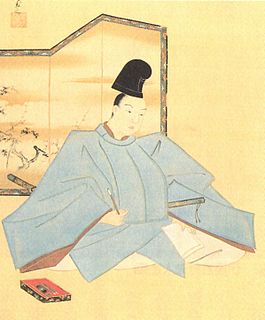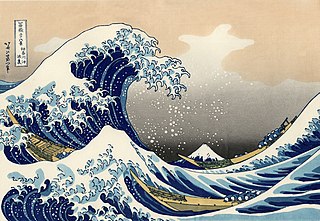
Sanada Yukimura , actual name: Sanada Nobushige , was a Japanese samurai warrior of the Sengoku period. He was especially known as the leading general on the defending side of the Siege of Osaka.

Katakura Kagetsuna was a Japanese samurai of the Katakura clan during the late Sengoku period. Also known by his court title, Bichū no Kami (備中守), or more commonly, as Katakura Kojūrō. Together with Oniniwa Tsunamoto and Date Shigezane, Kagetsuna was known as one of the "Three Great Men of the Date Clan". The son of Yonezawa native Katakura Kagenaga, he was famed for his role as a senior retainer under Date Masamune. He first served the Date clan as a junior page under Date Masamune's father Terumune. Then, on Endō Motonobu's recommendation, he became Masamune's personal attendant, and was heavily relied upon as a strategist. Kagetsuna would soon become deeply trusted by his lord, as the following anecdote illustrates: Masamune, in his first battle, suddenly found himself surrounded; he was only saved when Kagetsuna arrived on the scene shouting "I am Masamune!", distracting the enemy long enough for Masamune to escape.

Ichinoseki Domain was a tozama feudal domain of Edo period Japan It was located in Mutsu Province, in northern Honshū. The domain was centered at Ichinoseki jin'ya, located in the center of what is now the city of Ichinoseki in Iwate Prefecture.

Katakura Shigenaga was a Japanese samurai of the Azuchi-Momoyama period through early Edo period. The son of Katakura Kagetsuna, Shigenaga was the second man to bear the common name Kojūrō. His name was originally Shigetsuna; however, to avoid conflict with the fourth shōgun Ietsuna's name, he changed it to Shigenaga. In 1614, he took part in the Osaka Campaign, fighting Gotō Matabei at Dōmyōji Temple.
Katakura Muranaga (片倉村長) was a Japanese samurai of the Edo period. A senior retainer of the Sendai domain, he was first known as Masanaga (政長). Muranaga was also the fourth Katakura Kojūrō. His childhood name was Sannosueke (三之助) later changed to Kojūrō.
Katakura Murayasu (片倉村休) (1683-1720) was a Japanese samurai of the Edo period. A senior retainer of the Sendai domain, he was first known as Kageakira (景明). Murayasu was also the fifth Katakura Kojūrō. His childhood name was Sannosueke (三之助) later changed to Kojūrō. His father was Katakura Muranaga and his Mother was Matsumae Ichiko.
Katakura Muranobu (片倉村信) was a Japanese samurai of the Edo period. A senior retainer of the Sendai domain, he was the sixth Katakura Kojūrō. His childhood name was Date Kiyonosuke (伊達喜世之助) later become Kojuro later changed to Sukesaburo (助三郎). His name later changed from Katakura Muranobu back to Date Murashige (伊達村茂).
Katakura Muratsune (片倉村典) (1757–1822) was a Japanese samurai of the Edo period. A senior retainer of the Sendai domain, he was first known as Kagenaka (景仲) and Murayasu (村寿). Muratsune was the ninth Katakura Kojūrō. He was appointed as bugyō in 1797. His childhood name was Shigegoro (繁五郎). On October 27, 1815, he fell ill, and resigned his position as bugyō in favor of his son Kagesada. Retired in 1817.
Katakura Kagesada (片倉景貞) (1775-1840) was a Japanese samurai of the Edo period. A senior retainer of the Sendai domain. Kagesada was the tenth Katakura Kojūrō. His childhood name was Sannosuke (三之助) later Kojuro. His father was Katakura Muratsune and his son was Katakura Munekage.
Katakura Munekage (片倉宗景) (1798-1871) was a Japanese samurai of the Edo period. A senior retainer of the Sendai domain. Munekage was the eleventh Katakura Kojūrō. His childhood name was Sannosuke (三之助) later Kojuro. His father was Katakura Kagesada and his son was Katakura Kuninori.
Katakura Kuninori (片倉邦憲) (1818–1886) was a Japanese samurai of the Edo period. A senior retainer of the Sendai domain. Kuninori was the twelfth Katakura Kojūrō, and saw action under Sendai command in the Boshin War. During the war, his castle of Shiroishi became the command post for Sendai forces, as well as the administrative center of the Ouetsu Reppan Domei. His father was Katakura Munekage. His wife was Aihime, Date Munehira’s daughter and his son was Katakura Kagenori.
Katakura Kagenori (片倉景範) (1838–1902) was a Japanese samurai of the Edo period, and served as a senior retainer of the Sendai domain. Kagenori was the thirteenth Katakura Kojūrō. Kagenori moved with his father and a group of the Katakura clan retainers to Hokkaidō. His father was Katakura Kuninori and his mother was Aihime, Date Munehira’s daughter. His son was Katakura Kagemitsu.
Katakura Kenkichi (片倉健吉) (??-??) was a Japanese nobleman of the Meiji era. Kenkichi would have been the fifteenth Katakura Kojūrō. Served as chief priest of Aoba Shrine, in Sendai. Held the title of baron.

The Katakura clan is a Japanese family which claims its descent from Fujiwara no Toshihito by way of Katō Kagekado. The family entered Mutsu Province in the 14th century as subordinates of the Ōsaki clan. However, in 1532, they became retainers of the Date clan, and remained so until 1872. In the Sengoku era, the Katakura took part in all the major campaigns of the Date clan. The family's head, Katakura Kagetsuna, became renowned throughout the country, even receiving praise from Toyotomi Hideyoshi, who granted Kagetsuna a fief.

Date Yoshimura was an mid-Edo period Japanese samurai, and the 5th daimyō of Sendai Domain in northern Japan, and the 21st hereditary chieftain of the Date clan. The longest-serving of any of the daimyō of Sendai Domain, Yoshimura placed the domain back on sound financial footing.
Motoko Katakura was a Japanese anthropologist specialized in Islamic and multi-culture of desert.
Chikurin-in (竹林院) was a Japanese woman of the late Azuchi-Momoyama through early Edo period. She was Ōtani Yoshitsugu's daughter, then she was adopted by Toyotomi Hideyoshi, before marrying Sanada Yukimura (Nobushige). She is described as having been very beautiful. They had two sons and four daughters.






